Bayonetta's High-Flying, Pistol-Stiletto Burlesque
By Daneian 30 Comments
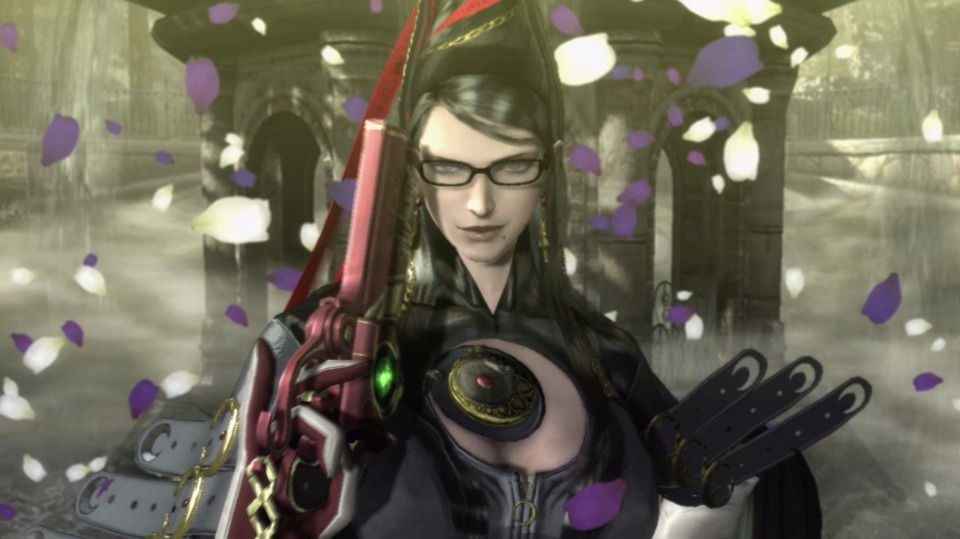
Lights Down, Curtain’s Up
Bayonetta's prologue starts conservatively, with a nun clad in white quietly praying over a grave. It primes the world’s Victorian aesthetics with a puritanical morality up front that wouldn’t fool anyone who had seen even the box art. That a flock of angels descend from heaven and attack, cutting the clean fabric and revealing the scantily-clad Umbran Witch underneath who responds by flying through the air, using the two guns in her fists and the two on her feet to shoot most of them in the head and scissoring her legs around another’s, is perhaps the proper way to open the show.
‘Theatrical’ is an apt way to describe the spectacle that follows, but there’s a more accurate term. The contrast of historical traditions with modern sensibilities, the exaggerated parodies of its subject matter, and the cheeky application of violence, all elevate it to the level of absurdist comedy. Add in the hip-hop, break- dancing that forms the combat and the risqué exhibitionism that expresses it and it’s clear that Bayonetta exists in the realm of the burlesque. It’s theater employing comical, larger than life performers, chief among them the titular protagonist, but she radiates charisma and a commanding stage presence. She captures the audience but doesn’t play to it.
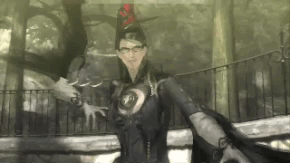
Bayonetta is director Hideki Kamiya’s response to the macho persona he created with Devil May Cry’s cool poster child Dante, applying many of those same concepts but giving his leading lady and her mechanics a grace and beauty those games have no interest in. His experiences on Viewtiful Joe and Okami accentuated the Witch’s characterization in ways significant and vivid, from her melee buttons and the slow-mo mechanic of her dodge to the flowers that spring up beneath her feet when she runs in panther form. With Bayonetta, Kamiya re-evaluated DMC’s core concepts, doing more than just slapping guns to Dante’s feet.
Her basic moves are simple enough. Punches and kicks. But the combination of those attacks with stick motions is the dance at the heart of the game’s design. It has rhythm and circularity; rhythm in the beats and rests of attacks, and the circularity of motion used to move between enemies, direct attacks or manually aim your firearms. The game is about fluidity and finding the right time to break and take the fight to the ground or the air. It’s absolutely a joy to play.
At first glance, the choice of wardrobe could seem cheap and exploitative titillation, but there’s something frank and honest about it; a black, skin-tight cat suit that’s actually Bayo’s hair that recedes and weaves into large appendages, it reinforces her open sexuality and has interesting implications for the gameplay. First and foremost, the Wicked Weaves increase the scope and range of her actions, closing the relative gap between the player and her enemies but also altering the very dynamic of the games flow. The disrobing further refutes the chaste symbolism we started with. Bayonetta dances, but not to anyone else’s drums.
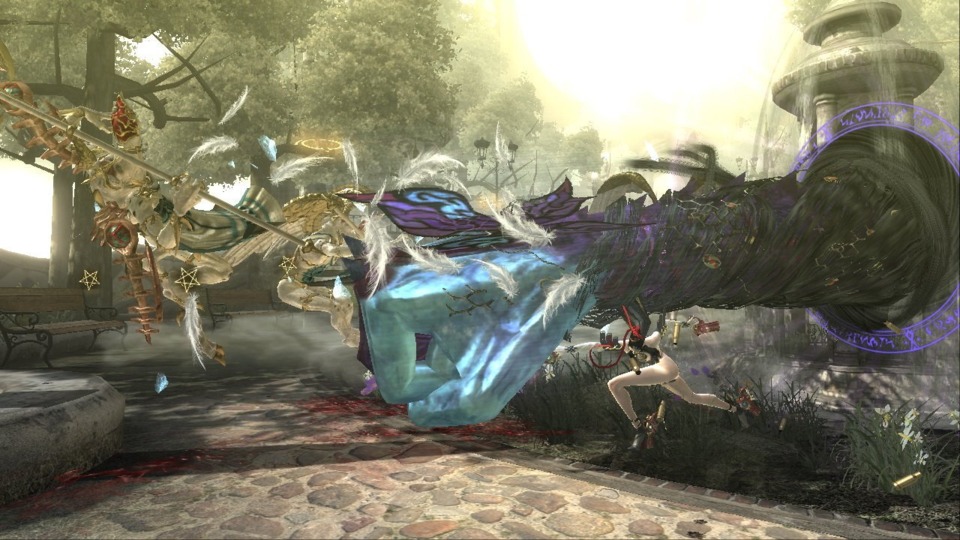
Dance, Dance, Dance
A scene where Bayonetta and her rival Jeanne, standing on their hands and engaged in a choreographed melee gun battle that has them swatting away the pistols strapped to their feet as bullets whiz by their faces, perfectly represents the spirit of the games combat. The player is then tested on their understanding of the gameplay that got them there as the mechanics they’d come to rely on are mercilessly thrown their way atop a chunk of earth hurtling through the air. The clash climaxes with an epic power struggle of gigantic fists filling the screen.
The dance-like combat works in small time frames of actions that build dance phrases of chained combos down the line. Since Bayonetta’s moves have negligible startup and recovery phases and everything backed up by the dodge offset that delays your combo to accommodate another input, her performance can be reactive, supporting frantic mashing but rewarding measured patience. At a higher level, the design truly represents its musical ambitions with placement of rests between hits to create rhythmic combat with different moves transitioning based on her position in the animation.
It doesn’t matter if Bayonetta’s gun heels started as a stylistic choice or a gameplay one, their ultimate advantage is to extend an attack’s function. It’s simple in theory and practice: hold a move after its attack animation and you’ll shoot. Sure, you can gun enemies down separately, but by adding them to the combat flow, you are given the tools to never let up your offensive and can change up the dynamics on a microscopic scale without breaking your long term plan. Want to get that large fist onscreen to knock away the three enemies you’re nimbly prancing around? You can, even if you end up needing to get some shooting in before continuing your dance.
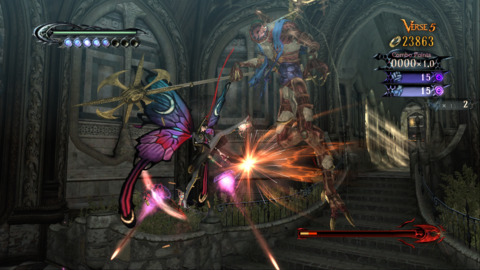
Bayo’s weapons truly open up the combat. With an arsenal bigger than Devil May Cry’s, there’s a wide range of abilities that can be exploited and combined. Though weapons like the Sharuba katana might be standard and the Onyx Roses shotguns have a great kickback, the ice skates Odette and the fire/lightning Durga claws not only provide interesting elemental affinities, but strategically change up the pacing, freezing enemies to be thrown into others in the former, and remixing the held moves to charge an AOE attack in the latter. Considering that each weapon was provided with unique move string for every equip combination possible, your options are truly staggering, to say nothing of the configurable weapon toggle that further extends the combo possibilities to infinity, turning every one of her numbers into a face-breaking break-dance of destruction.
The performance is an offensive one, but even its primary defensive maneuver portrays a nimble agility. Timing her evasive backflip to the moment of an enemy’s attack activates Witch Time to slow the battle and open a chance to pummel your foes. Placing the mechanic on evade is execution friendly, reducing its risk of error. The worst mistake you can make is timing it late- an early input will at least still dodge. More advanced is the Moon of Mahaa-Kalaa, an accessory reminiscent of Street Fighter 3’s awesome parry mechanic. The source of the most blunt impact in the game, pushing towards an enemy will repel an attack and stagger with a concussive clop in-game and a knock on the controller, countering and activating a reduced Witch Time if hit in its last frames.
It can’t be over-stressed how highly adjustable the moveset allows the combat to be, and how fun and satisfying it is to execute in the heat of the moment. Advanced players can easily change up their tactics on the fly based on the ebb and flow of the battlefield. Put it all together and the combat has a terrific tempo. With the kicks and punches as the lowest divisible unit, what starts as miniature beats builds to wicked weaves that punctuate the rhythm into the button barrages of the torture QTE’s. You get punch into punch into kick then rest into kick and kick into juggle, switch, punch, charge, dodge, punch, kick, kick weave knock knock switch punch punch punchpunchpunchpunchpunchpunchpunchweave. CLIMAX!
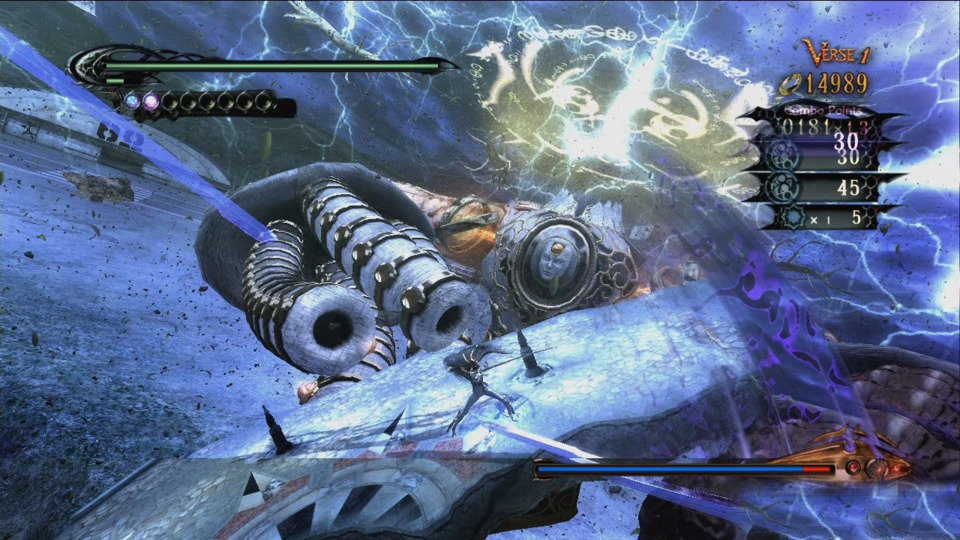
All The World’s A Stage
The combat pacing is well suited to the conventional structures of classical performance art. Bayonetta’s individual scenes, appropriately referred to as verses, subdivide chapters, each of which culminate in over the top climaxes that resolve with Bayo summoning a massive hair demon to devour the giant forces of Heaven with marked pizzazz. And though many have you jamming feverishly on a button, the climaxes are always fulfilling and usually involve tearing the holy hell out of the environment. Boss battles are inspired for how well their events follow fight-QTE-fight to limit fatigue.
Bayonetta makes the case that Devil May Cry needed to shrug off its Resident Evil legacy. Bayonetta’s made of consecutive maps rather than a single cohesive area gated by unfortunate lock-and-key puzzles and the resulting filler backtracking that diverted too much away from the deep combat systems. (Ya know, to be fair, Bayonetta does have puzzle-lite miscellaneous activities including taking a giant key to a door and using Witch Time to do ‘awesome’ things like cross a temporary bridge and run across solid water- these segments suck for how obviously they are meant to vary up lame downtime in the runnin’ around portions of the game.) What remains is a little thing called plot, from which insane things can happen on the regular.
Battles come to life through technically impressive environmental art and programming. Huge architecture ripped from the ground and gravity-defying changes in perspective are par for the course, the best of which has you running up the walls and ceiling in pursuit of your prey. That its creativity is boundless without being gimmicky or self-congratulatory is testament to the confidence of its construction. Most importantly, the camera excels, maintaining a clean focus on the action and rarely being obscured by it.
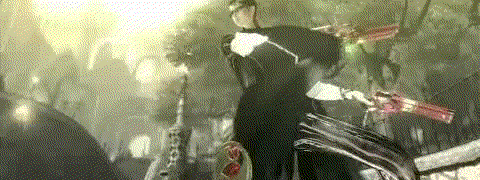
Bayonetta’s characterization translates between story and gameplay in a way rare to videogames. Even if you’re not a fan of her personality, it’s hard to argue that her behaviors and actions in the cinematics aren’t consistent with her abilities as a vehicle for combat. Scenes where she’s strutting on enemies, heels shooting them with every step complement the act of slapping one into the air and double-jump-kicking it into oblivion. For as well-defined as she is, members of her supporting cast are unfortunately less so, including a wooden husk with dialogue for a merchant and a grating gangster wannabe whose screen time is thankfully brief. Much of the enemy design is rote too, Christian aesthetics composed of gilded techno angels.
But the game’s deficiencies are more than made up for by its self-aware satire. Most of it comes from Bayonetta’s winking mockery of the genre, including her boredom with the monologues spewed by some of her adversaries. Asura’s Wrath would carry Bayonetta’s cheesy flag a few years later, arguably doing it better by the priorities of its design, but the respect both show is palpable. PlatinumGames' partnership with Sega was lovingly exploited in dozens of homages to not only their staple of classic games but in the legacy of the creators of this one. But they’re miniscule compared to the Afterburner-esque motorcycle carnage on Route 666 or the missile-riding shooting mission that’s so Space Harrier that it’s greeted with a warm ‘Welcome to my fantasy zone.’ The line may originate from another game, but it came from our heroine’s lips. That’s what should stick; the frisky and flirtatious femme fatale center stage, grooving to her own beat. It’s unahamed, unrelenting fun.
So the curtain falls and the lights come up and you sit in your seat begging for a repeat performance. There was so much energy radiating from the stage that you know that Hideki Kamiya and crew were having a blast with every minute of its production. And under the spotlight, casting a butterfly shadow, Bayonetta gave us an encore.
